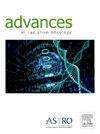Risk Estimation of Late Rectal Toxicity Using a Convolutional Neural Network-based Dose Prediction in Prostate Cancer Radiation Therapy
IF 2.7
Q3 ONCOLOGY
引用次数: 0
Abstract
Purpose
The present study investigated the feasibility of our automatic plan generation model based on a convolutional neural network (CNN) to estimate the baseline risk of grade ≥2 late rectal bleeding (G2-LRB) in volumetric modulated arc therapy for prostate cancer.
Methods and Materials
We built the 2-dimensional U-net model to predict dose distributions using the planning computed tomography and organs at risk masks as inputs. Seventy-five volumetric modulated arc therapy plans of prostate cancer, which were delivered at 74.8 Gy in 34 fractions with a uniform planning goal, were included: 60 for training and 5-fold cross-validation, and the remaining 15 for testing. Isodose volume dice similarity coefficient, dose-volume histogram, and normal tissue complication probability (NTCP) metrics between planned and CNN-predicted dose distributions were calculated. The primary endpoint was the goodness-of-fit, expressed as a coefficient of determination (R2) value, in predicting the percentage of G2-LRB-Lyman-Kutcher-Burman-NTCP.
Results
In 15 test cases, 2-dimensional U-net predicted dose distributions with a mean isodose volume dice similarity coefficient value of 0.90 within the high-dose region (doses ≥ 50 Gy). Rectum V50Gy, V60Gy, and V70Gy were accurately predicted (R2 = 0.73, 0.82, and 0.87, respectively). Strong correlations were observed between planned and predicted G2-LRB-Lyman-Kutcher-Burman-NTCP (R2 = 0.80, P < .001), with a small percent mean absolute error (mean ± 1 standard deviation, 1.24% ± 1.42%).
Conclusions
A risk estimation of LRB using CNN-based automatic plan generation from anatomic information was feasible. These results will contribute to the development of a decision support system that identifies priority cases for preradiation therapy interventions, such as hydrogel spacer implantation.
基于卷积神经网络的前列腺癌放射治疗剂量预测的晚期直肠毒性风险评估
目的探讨基于卷积神经网络(CNN)的自动计划生成模型用于估计前列腺癌体积调节弧线治疗中≥2级晚期直肠出血(G2-LRB)基线风险的可行性。方法和材料我们建立了二维U-net模型来预测剂量分布,使用规划计算机断层扫描和危险器官面罩作为输入。75个前列腺癌体积调制弧线治疗方案,以74.8 Gy的剂量分为34个部分,具有统一的计划目标,其中60个用于训练和5倍交叉验证,其余15个用于测试。计算计划剂量分布和cnn预测剂量分布之间的等剂量体积骰子相似系数、剂量-体积直方图和正常组织并发症概率(NTCP)指标。主要终点是预测G2-LRB-Lyman-Kutcher-Burman-NTCP百分比的拟合优度,以决定系数(R2)值表示。结果在15例试验中,二维U-net预测高剂量区(剂量≥50 Gy)内的剂量分布,平均等剂量体积骰子相似系数为0.90。直肠V50Gy、V60Gy、V70Gy预测准确(R2分别为0.73、0.82、0.87)。计划的G2-LRB-Lyman-Kutcher-Burman-NTCP与预测的g2 - lrb - lyman - kutcher - ntcp有很强的相关性(R2 = 0.80, P <;.001),平均绝对误差很小(平均±1个标准差,1.24%±1.42%)。结论采用基于cnn的基于解剖信息的自动计划生成方法对LRB进行风险评估是可行的。这些结果将有助于决策支持系统的发展,以确定放射前治疗干预的优先病例,如水凝胶间隔植入。
本文章由计算机程序翻译,如有差异,请以英文原文为准。
求助全文
约1分钟内获得全文
求助全文
来源期刊

Advances in Radiation Oncology
Medicine-Radiology, Nuclear Medicine and Imaging
CiteScore
4.60
自引率
4.30%
发文量
208
审稿时长
98 days
期刊介绍:
The purpose of Advances is to provide information for clinicians who use radiation therapy by publishing: Clinical trial reports and reanalyses. Basic science original reports. Manuscripts examining health services research, comparative and cost effectiveness research, and systematic reviews. Case reports documenting unusual problems and solutions. High quality multi and single institutional series, as well as other novel retrospective hypothesis generating series. Timely critical reviews on important topics in radiation oncology, such as side effects. Articles reporting the natural history of disease and patterns of failure, particularly as they relate to treatment volume delineation. Articles on safety and quality in radiation therapy. Essays on clinical experience. Articles on practice transformation in radiation oncology, in particular: Aspects of health policy that may impact the future practice of radiation oncology. How information technology, such as data analytics and systems innovations, will change radiation oncology practice. Articles on imaging as they relate to radiation therapy treatment.
 求助内容:
求助内容: 应助结果提醒方式:
应助结果提醒方式:


